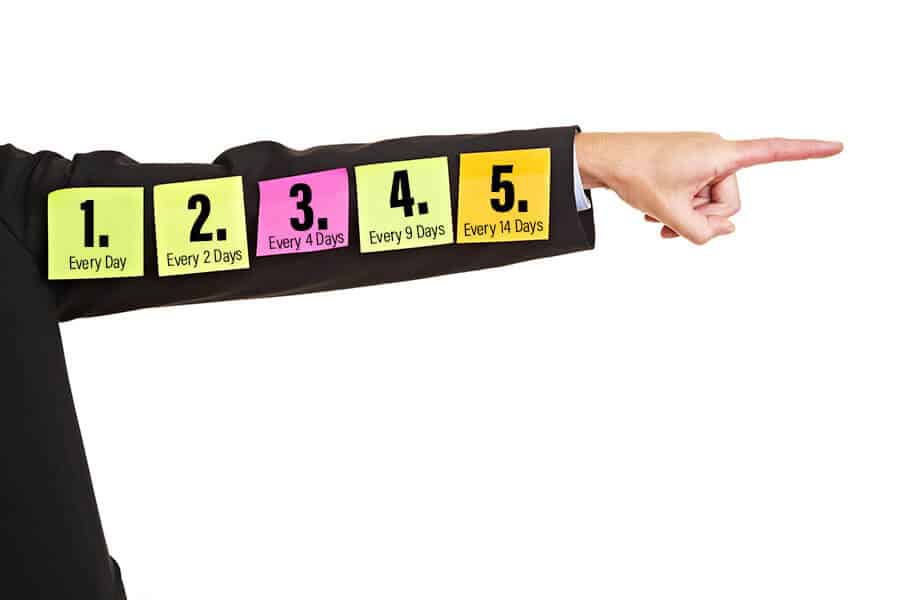Learn how to improve your memory and be a more effective learner! The short-term memory can only hold on to five to seven things at a time. So if you want the information to stick, work on building those neuron connections! Since highlighting and cramming aren’t useful, here are techniques on how to learn the right way.
The Theory of Learning
You can hear people say they are ‘on a steep learning curve’. What that usually means is that they are in the process of learning. They haven’t yet mastered something and there is more to practice. The term ‘learning curve’ can be traced back to the work of Hermann Ebbinghaus, a German psychologist who studied the processes of learning and forgetting in the late 19th century.
Ebbinghaus was determined to study how humans acquire information. His study was based on asking test participants to memorize a list of symbols and then see how much they remembered afterwards. Using actual words would provide inaccurate results because of prior knowledge and the associations the participants might have. For this reason, Ebbinghaus decided to use lists of random nonsense syllables in the form of consonant-vowel-consonant, e.g. DAX, WER, KIB.
Once the psychologist had created a list of 2,300 syllables, he would take a number of random syllables and write them down in a notebook. Then he would read them at a constant speed and try to recall the order at the end of the procedure. The goal was to understand why information fades away over time. And that’s how Ebbinghaus created the forgetting curve.

The Forgetting Curve
Ebbinghaus discovered that if one repeats information at regular intervals, the participants in the study will forget less. And that’s what the graph is showing. The red line illustrates how a lack of revision results in forgetting almost everything over a week. At the same time, if you space out your revision, you are able to retrieve more over longer periods of time.
According to Ebbinghaus, periodic revision over a longer period of time is more effective than a single long session. And that’s when spaced repetition comes in handy.
Leitner System for Spaced Repetition

To ensure that you can both remember and retrieve information fast, apply spaced repetition to going over any material that you need to learn. Ebbinghaus found that learning 12 nonsense syllables took him 68 repetitions one day and then seven repetitions the next day. However, when he spaced out the task over three days, it took him half as many repetitions. Here is an easy system designed by German science journalist Sebastian Leitner.
The Leitner system divides the study material into five categories. Each category needs to be revised at different frequencies depending on the difficulty of the material.
To create a physical system, you’ll need flashcards to write down the information and small boxes to separate flashcards. Information can be in the form of a definition, a formula, a long answer, a fact, etc.
Each category has a schedule of when to be revised
- Box 1 – Every Day
- Box 2 – Every 2 Days
- Box 3 – Every 4 Days
- Box 4 – Every 9 Days
- Box 5 – Every 14 Days
On Day 1 you put all the flashcards into Box 1. Then if you correctly answer a question, you move it into the next box. If you get something wrong, you place it in Box 1 again.
To supplement the spaced repetition technique, try to recall actively what you’ve learnt.
Active Recall Method
Imagine how calm you are when you have a textbook and the whole Internet to search for answers. Now imagine having to close all the tabs, hide your textbooks and notes and see what’s inside your head. A trap that many students fall into is that they think they know something when in fact they only recognize the information. Active recall is the process of retrieving information. It is a way to see where you are with your revision and compare what you know to what’s in the curriculum. Here are three methods that work:
Timed mind mapping. For this you will need to hide all sources of information, set a timer and write everything you know on a topic sheet. The mind map format is useful because it shows you the connections between ideas and helps to structure the logical answer.
Oral rapid fire with a buddy. For this method you will need a buddy who will hold you accountable. You can use flashcards from the spaced recall method and time how fast and how accurately you can recall the information. Discuss all the questions you got wrong and focus on them using the next method.
Create a practice test. Using a simple Google form, create a test to consolidate the information. For multiple choice questions, thinking of right and wrong options will help you to see typical mistakes. If you divide topics amongst your friends, you can then each discuss the results in detail.
Create Mnemonics

A way to remember long lists of terms or sequences of actions is to create a mnemonic. This is a little trick that helps you to associate new material with what you already know. It could be a lyric modification, a rhyme, a sentence, an abbreviation or the use of words that start with the same letter.
Here are some tips for creating catchy mnemonics:
Change the lyrics of a song you like. It can be just a few lines, but sometimes changing the whole song can help you tackle a bigger topic. Like, for example, this biology video on gene editing.
Use your friends’ names. Especially if you are preparing for a class, it will be easy to associate your classmates and what you know about them with the material you are learning.
Be funny. The more emotions you associate with a concept, the better it will stick. Try to think about common everyday phenomena and related actions to help you illustrate the material.
Examples of mnemonics
Do you remember the order of the planets? My Very Educated Mother Just Served Us Nuts (Mercury, Venus, Earth, Mars, Jupiter, Saturn, Uranus, Neptune).
What about the colours of the rainbow? Imagine someone named Roy G. Biv (Red, Orange, Yellow, Green, Blue, Indigo, Violet).
A little bit of history and rhymes: In 1492, Columbus sailed the ocean blue.
English spelling:
I before e except after c
or when sounding like a
in neighbor and weigh
To supplement these new techniques, here are some useful resources to improve your study methods!
This blog is dedicated to productivity and exam techniques. Created by Thomas Frank, the website provides videos and articles on staying organized, managing time and building new habits.
Ultralearning by Scott H. Young
Can you imagine independently learning the whole curriculum of the Computer Science Bachelor’s program at MIT in 12 months? This is exactly what the author did as a way to prove that anything is possible. In the book, Young talks about meta-skills that one can apply to learning.
Anki App For Flashcards
Anki is a program that helps you to create flashcards for revision. You can add audio, video and images to supplement your flashcards. The platform also allows you to rate the questions based on difficulty and then shows you the ones you need to revise more often. This is a great resource for spaced repetition and active recall methods.
Explore various study methods to ensure you’re being as efficient as possible with the time you have. Remember that it takes both time and repetition to store information in the long-term memory. So don’t put off revision, and you will thank yourself later!
Photos: Shutterstock / edit: Martina Advaney
Support us!
All your donations will be used to pay the magazine’s journalists and to support the ongoing costs of maintaining the site.
Share this post
Interested in co-operating with us?
We are open to co-operation from writers and businesses alike. You can reach us on our email at [email protected]/[email protected] and we will get back to you as quick as we can.










